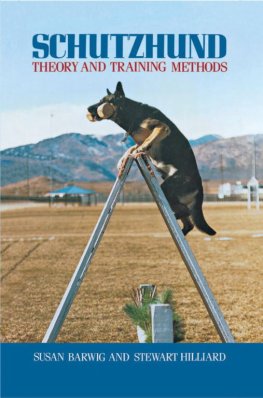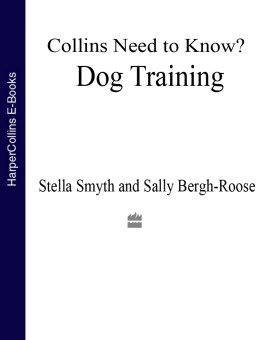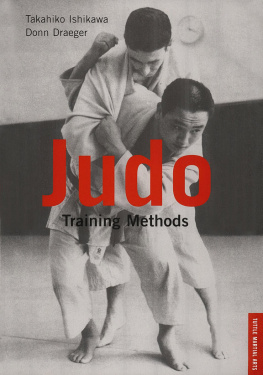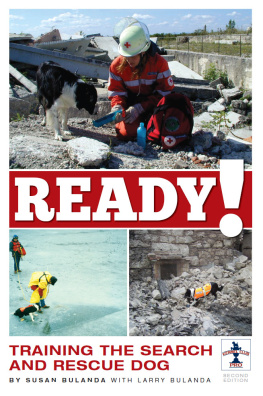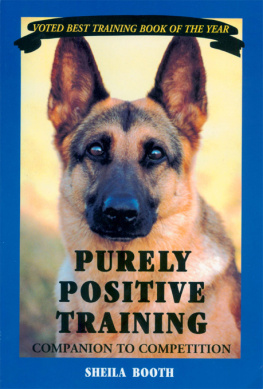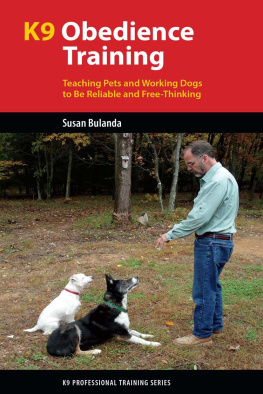Susan Barwig - Schutzhund: Theory and Training Methods
Here you can read online Susan Barwig - Schutzhund: Theory and Training Methods full text of the book (entire story) in english for free. Download pdf and epub, get meaning, cover and reviews about this ebook. year: 1991, publisher: Wiley, genre: Detective and thriller. Description of the work, (preface) as well as reviews are available. Best literature library LitArk.com created for fans of good reading and offers a wide selection of genres:
Romance novel
Science fiction
Adventure
Detective
Science
History
Home and family
Prose
Art
Politics
Computer
Non-fiction
Religion
Business
Children
Humor
Choose a favorite category and find really read worthwhile books. Enjoy immersion in the world of imagination, feel the emotions of the characters or learn something new for yourself, make an fascinating discovery.

- Book:Schutzhund: Theory and Training Methods
- Author:
- Publisher:Wiley
- Genre:
- Year:1991
- Rating:4 / 5
- Favourites:Add to favourites
- Your mark:
- 80
- 1
- 2
- 3
- 4
- 5
Schutzhund: Theory and Training Methods: summary, description and annotation
We offer to read an annotation, description, summary or preface (depends on what the author of the book "Schutzhund: Theory and Training Methods" wrote himself). If you haven't found the necessary information about the book — write in the comments, we will try to find it.
Schutzhund: Theory and Training Methods — read online for free the complete book (whole text) full work
Below is the text of the book, divided by pages. System saving the place of the last page read, allows you to conveniently read the book "Schutzhund: Theory and Training Methods" online for free, without having to search again every time where you left off. Put a bookmark, and you can go to the page where you finished reading at any time.
Font size:
Interval:
Bookmark:
SCHUTZHUND
SCHUTZHUND
THEORY
AND
TRAINING METHODS
Susan Barwig
and
Stewart Hilliard

Copyright 1991 by Susan Barwig and Stewart Hilliard
Howell Book House
Published by Wiley Publishing, Inc., New York, NY
No part of this publication may be reproduced, stored in a retrieval system or transmitted in any form or by any means, electronic, mechanical, photocopying, recording, scanning or otherwise, except as permitted under Sections 107 or 108 of the 1976 United States Copyright Act, without either the prior written permission of the Publisher, or authorization through payment of the appropriate per-copy fee to the Copyright Clearance Center, 222 Rosewood Drive, Danvers, MA 01923, (978) 750-8400, fax (978) 646-8700. Requests to the Publisher for permission should be addressed to the Legal Department, Wiley Publishing, Inc., 10475 Crosspoint Blvd., Indianapolis, IN 46256, (317) 572-3447, fax (317) 572-4447, E-Mail: permcoordinator@wiley.com.
Trademarks: Wiley, the Wiley Publishing logo, and Howell Book House are trademarks or registered trademarks of Wiley Publishing, Inc., in the United States and other countries, and may not be used without written permission. All other trademarks are the property of their respective owners. Wiley Publishing, Inc., is not associated with any product or vendor mentioned in this book.
Limit of Liability/Disclaimer of Warranty: While the publisher and author have used their best efforts in preparing this book, they make no representations or warranties with respect to the accuracy or completeness of the contents of this book and specifically disclaim any implied warranties of merchantability or fitness for a particular purpose. No warranty may be created or extended by sales representatives or written sales materials. The advice and strategies contained herein may not be suitable for your situation. You should consult with a professional where appropriate. Neither the publisher nor author shall be liable for any loss of profit or any other commercial damages, including but not limited to special, incidental, consequential, or other damages.
For general information on our other products and services or to obtain technical support please contact our Customer Care Department within the U.S. at 800-762-2974, outside the U.S. at 317-572-3993 or fax 317-572-4002.
Library of Congress Cataloging-in-Publication Data:
Barwig, Susan.
Schutzhund : theory and training methods / by Susan Barwig and Stewart Hilliard.
p. cm.
Includes bibliographical references.
ISBN 978-0-87605-731-5
1. Schutzhund dogsTraining. I. Hilliard, Stewart. II. Title.
SF428.78.B37 1991
90-37408
CIP
636.73dc20
Manufactured in the United States of America.
25 24 23
Contents
Preface
When Susan Barwig published the first edition of this book in 1978, she meant it to be a basic introduction to the sport, an answer to the question What is Schutzhund?
In 1978, Schutzhund was a little-known and arcane discipline practiced by a few hundred devotees across the United States. They were regarded with suspicion and even horror by many American dog fanciers. In the United States there was no old and accepted tradition of working dogs, as there was in Western Europe, and twelve years ago Americans tended to associate any sort of biting-dog training with shady characters in greasy overalls who fed their dogs gunpowder in order to make them mean.
In 1978, advertisements for German Shepherd Dogs mentioned side gait more often than working ability, and not many people considered a pedigree full of German Schutzhund III dogs a selling point for a litter of puppies.
In 1978, animals with AKC Companion Dog titles were advertised as working dogs. Much has changed in twelve years.
Dog World is now crammed full of ads for German Shepherds, Rottweilers and Doberman Pinschers imported from Germany, all of them proudly announcing the animals titles and accomplishments in Schutzhund sport. The United Schutzhund Clubs of America have even instituted a controlled-breeding program (modeled after that of the German Shepherd Dog Club of Germany) which emphasizes not only selection for correct conformation but also the deliberate promotion of character and working ability.
We are becoming acquainted with a new visionthe idea that dogs should be admired for more than pretty ears, a handsome coat, a correct topline and a perfect tail.
Now many of us look for character in our dogs rather than just conformation and beauty. We admire a fine working animaland call it finefor its courage, its spirit and its power. In short, it is formidable rather than just adorable. Instead of doting on it and spoiling it as we invariably seem to do with beauty dogs, we respect this animal for its power, love it for its devotion to us and keep and train it responsibly because of our respect for it.
Now more Americans than ever are asking What is Schutzhund? This book, like its predecessor, is designed to answer this question, giving the reader a feeling not just for the mechanics and ritual of a Schutzhund trial, but also for the theory and the atmosphere of the sport.
However, much more than its predecessor, it is also designed to convey a good general understanding of Schutzhund training and also many specific techniques for teaching the dogs. We think that Schutzhund: Theory and Training Methods will prove fascinating not only to novices getting their first introduction to the sport, but also to seasoned trainers looking for a new perspective.
The Requirements chapters describe what the dog must do in a trialmuch more simply and readably than in a rule book.
The Overview chapters give the reader general information about, and also hopefully some insight into, each of the three phases of Schutzhund and the demands that they place on the animal.
The training chapters break all of the exercises which the dog must learn down into simple steps designed to be easily grasped by the animal, and also arrange them into meticulous progressions (the careful layerings of skills and concepts that eventually evolve into polished exercises).
For reasons of space, we were unable to describe the schooling of all the exercises in Schutzhund in full detail in this introductory volume. We were forced to be selective, especially in protection training, which is very complex.
We give a reasonably detailed picture of the theory and methods of drive work, because basic agitation is the foundation upon which all other training is based. Because the hold and bark and the out are by far the two most important skills of control, we treated them in some detail. With respect to those two exercises, we hope that we have succeeded in conveying a rich understanding of our methods to the reader and imparted information and ideas that can actually be used on the training field.
On the other hand, our methods for the blind search and what we call obedience for bites are subtle and complicated, and to describe them in detail would have required another volume.
Throughout the book we have employed the pronoun he to refer to the handler and also the agitator and the assistant in training. No sexism is implied. We fully recognize that there are many extremely capable female dog trainers in the sport. Our decision to use the masculine pronoun was prompted by stylistics, not chauvinism.
About the Authors
Susan Barwig holds masters degrees in both education and psychology, and currently teaches in the Graduate School of Education at the University of Colorado.
Next pageFont size:
Interval:
Bookmark:
Similar books «Schutzhund: Theory and Training Methods»
Look at similar books to Schutzhund: Theory and Training Methods. We have selected literature similar in name and meaning in the hope of providing readers with more options to find new, interesting, not yet read works.
Discussion, reviews of the book Schutzhund: Theory and Training Methods and just readers' own opinions. Leave your comments, write what you think about the work, its meaning or the main characters. Specify what exactly you liked and what you didn't like, and why you think so.

